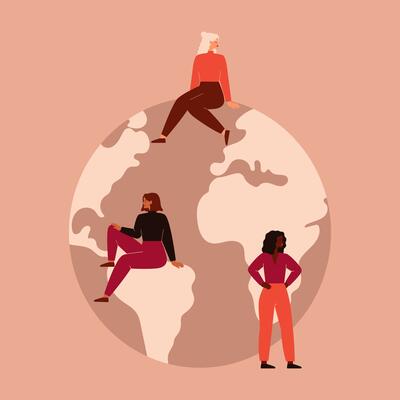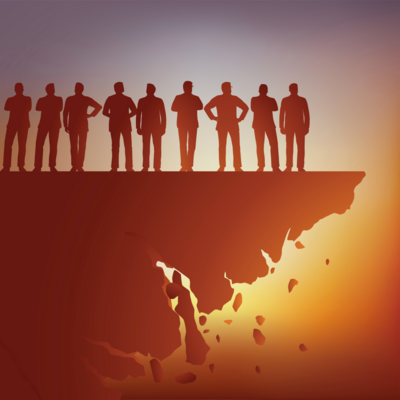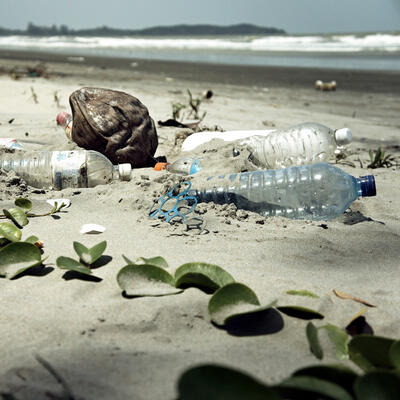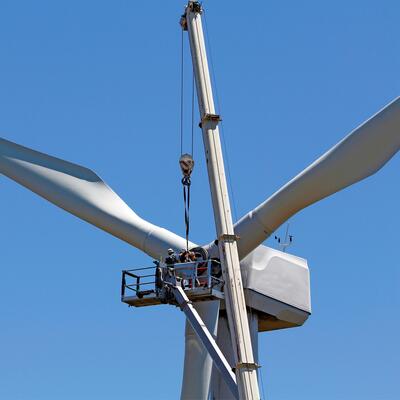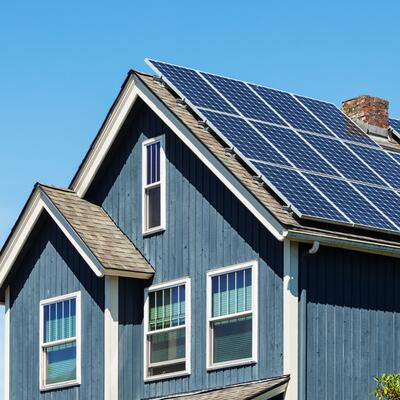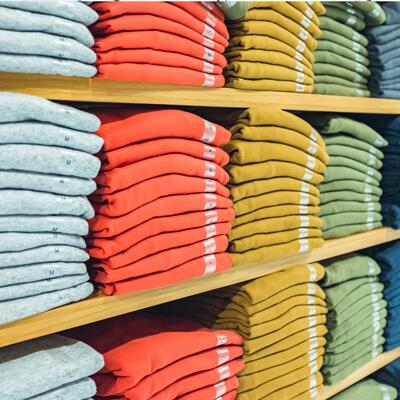
Wardrobe Malfunction: The Climate Impact of Clothing
Guests

Aja Barber

Jason Kibbey
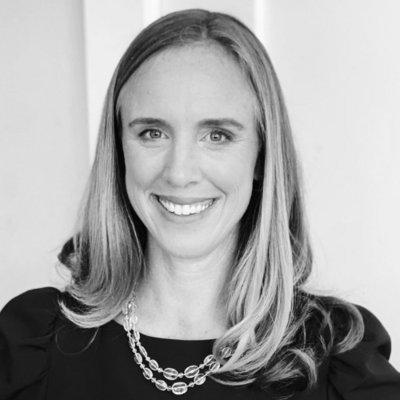
Molly Morse
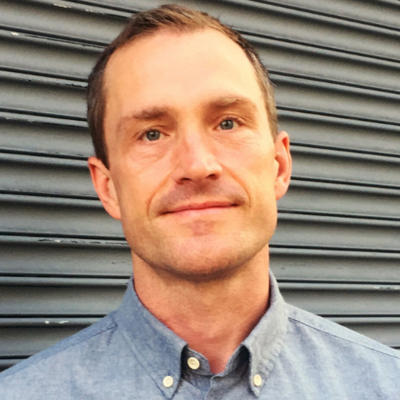
Jonathan Chapman
Summary
Clothing may not be one of the top things you think about in terms of climate solutions, but the way we source, make and churn through clothes has a big impact on emissions, land and water use. And that’s apart from the other harms it can have on workers and public health.
“At the beginning and the end of this linear system, people in the Global South are harmed,” says Aja Barber, author of “Consumed: The Need for Collective Change: Colonialism, Climate Change and Consumerism.” She says that unlike other costs of living, the cost of clothing has actually gone down. “And the reason the cost has gone down is because there's so much exploitation built into this process.”
“80 percent of garment workers are women,” Barber says, and “chances are, that woman is also going to be brown or Black.” And as global companies race to the bottom, making far more clothing than we need, consumer-driven culture and the rise of online shopping have convinced us that we perpetually need more. “Because we buy so much more clothing now than we did in 1990, we are cycling through garments at a speed that the planet cannot keep up with.”
When those of us in wealthy countries are done with our clothes and discard them, they make their way back to the Global South where they fill up landfills and pollute waterways. A recent article in Grist detailed an immense stockpile of abandoned clothing in the Atacama Desert in northern Chile that caught fire, creating toxic smoke.
But in recent years the clothing and footwear industries have tried to improve their processes, says Jason Kibbey, former CEO of the Sustainable Apparel Coalition. That group developed tools for companies to measure and score their environmental impacts. Kibbey says those voluntary efforts will soon be backed by regulations being drafted in the European Union.
“They basically say first, you have to understand as a company how much of an impact that you're making, and that really requires collecting primary data, really knowing your value chain, knowing what happens to your products at the end of their life,” Kibbey says. “And then you have to actually take account for that, and show how you're improving that and ultimately, how you are living within planetary boundaries.”
To stay within planetary boundaries, Kibbey says we should each only be buying something like 5 new clothing items a year, but the average American buys somewhere around 60 or 70. So buying less, buying used, and prioritizing quality and longevity can help us individually contribute less to this global problem.
Still, we do need to buy new things from time to time. A lot of today’s clothing is actually made of petroleum derivatives – oil, essentially, turned into polyester. Several companies are working to design new materials that are better for the environment. Molly Morse is CEO of Mango Materials, which creates a plastic substitute – a polymer created from waste methane that is biodegradable at the end of its life.
“Our dream climate impact would be to have Mango Materials production facilities…all over the world, where we are converting this potent greenhouse gas into environmentally friendly alternatives to conventional plastic. And then also this material that's produced, whether it's in yoga pants or molded goods or films, if it's improperly disposed of, it could enter the naturally-occurring carbon cycle or what would be preferred is it would be recycled and reused, but we would be capturing this carbon and keeping it in play,” she says.
This episode was supported by BMO.
Episode Highlights
4:00 Aja Barber on harms of our modern clothing systems and supply chains
11:00 We should buy clothes more like we did in the ‘90s
13:00 What happens to your clothes when you donate them to thrift stores–and how they get to the Global South
16:30 Aja’s advice on being a more conscious clothing consumer
23:20 Jason Kibbey on why he got involved with making clothes more sustainable
29:00 Challenges of reducing emissions and environmental impact while also growing sales
31:30 New regulations coming from European Union
35:20 Jason’s advice on being a more conscious clothing consumer
40:00 Jonathan Chapman on emotional durability of objects
46:00 Listener stories of clothes they’ve had forever
50:00 Molly Morse on how she creates a plastic alternative from waste methane
54:00 Extended producer responsibility
Resources From This Episode (3)
Full Transcript
Note: Transcripts are generated using a combination of automated software and human transcribers and may contain errors. Please check the actual audio before quoting it.
Greg Dalton: This is Climate One, I’m Greg Dalton.
Ariana Brocious: And I’m Ariana Brocious. Today we’re talking about clothes.
Greg Dalton: Right it’s fashion week here at Climate One!
Ariana Brocious: Fashion week! Hey nice sweater, Greg. Is it new?
Greg Dalton:Yes, Christmas.
Ariana Brocious: Well actually, wearing your existing wardrobe is way better for climate and the environment.
Greg Dalton: I know, it’s a great excuse to not be too focused on whether or not I’m fashionable.
Ariana Brocious: And clothing may not be one of the top things you think about in terms of climate solutions, but the way we source, make and churn through clothes has a big impact on emissions, land and water use. And that’s apart from the other harms it can have on workers and public health.
Greg Dalton: Yeah, we’ve all heard about the horrors of sweatshops. I was a reporter in China years ago and have actually spent time in garment factories. Many have cleaned up their operations and labor practices since then though dyeing clothes still creates a lot of water pollution and many clothing factories in Asia run on coal-fired electricity.
Ariana Brocious: And that’s just on the creation end of the line… When we in wealthy countries are done with our clothes and discard them, they make their way back to the global south where they fill up landfills and pollute waterways. In fact, I just read an article in Grist about an IMMENSE stockpile of abandoned clothing in the Atacama Desert in northern Chile that caught fire and burned, creating terrible, toxic smoke. It’s horrible.
Greg Dalton: Right, because a lot of what today’s clothing is actually made of is petroleum derivatives–oil, essentially, turned into polyester.
Ariana Brocious: There’s a lot to dig into on today’s show around the climate impacts of what we wear. And I want to highlight two numbers in the interviews you’re about to hear to give a frame for the role of an individual consumer: to stay within planetary boundaries, we should each only be buying something like 5 new clothing items a year, but the average American buys somewhere around 60 or 70.
Greg Dalton: That’s literally ten times higher. Wow.
Ariana Brocious: Yeah. We’ll talk about ways we can be more mindful clothing consumers throughout the show, but first I wanted to start with the situation now – and how our habits… and especially the rise of online shopping… are hurting someone else’s environment, and our atmosphere.
Aja Barber is author of “Consumed: The Need for Collective Change: Colonialism, Climate Change and Consumerism.” I talked with her from her home in London.
Ariana Brocious: Our current system of clothing manufacturing creates a lot of harm to workers and the environment and the climate. And so I want to walk through the process of making, let's say, one garment as a way to talk about each of those things and sort of the life cycle, perhaps, of a piece of our current modern clothing.
Aja Barber: Sure.
Ariana Brocious: So let's say I'm online. I'm shopping. I see a blouse I like. It's, you know, a bright color. Maybe it's made from some polyester synthetic. It has some, you know, drapey, style. So I buy it. I know that in a few short days, it's going to arrive on my doorstep. So walk me through the origin of an item like that and the harm that it creates just in getting to me.
Aja Barber: Okay. So what you need to understand is at the beginning and the end of this linear system, people in the global South are harmed and most of our clothing, the pricing is artificially depressed. It hasn't risen with the price of other things in our society. So housing, education, cars, things like that, all of that's gone up. The cost of clothing has actually gone down. And the reason the cost has gone down is because there's so much exploitation built into this process. So cotton farmers notoriously have a very challenging and difficult life to the point where there's a lot of depression among those communities in the global South. And so at the beginning, if you're getting a natural fiber, there's a good chance that someone is exploited in just the growing and selling of the fiber. If it's not a natural fiber, it's most likely going to be polyester. 60 percent of the fabrics on our planet currently are polyesters, and polyfibers are plastics. They come from fossil fuels. So I'm pretty sure you've probably done a lot of great shows on the harm of fossil fuels. Don't need to get into it. So–
Ariana Brocious: No, but I think we should, let's just pause there for a second. Cause I think that sometimes we forget that we're literally wearing like oil, it's an oil derivative, right? It's a product that's made from fossil fuels,
Aja Barber: Yes, the things that make our clothing stretchy are also the things that will be on the planet for longer than we will. We don't really know how long it's going to take for a lot of these polyfibers to biodegrade. And so people will talk about, oh, I need, I need the stretch in all of my clothing, but we're trading off on our planet. And when you wash polyfibers, they shed microfibers, and those microfibers get into our water, our soil, our food. our bodies. And so that's not a good system either. So, you know, you're either buying cotton or something that is synthetic, the product will then be produced most likely in the global South and the people producing and putting together the garment are humans. I think we think that, oh, these systems are automated. They are not. And there is something called the race to the bottom, which brands participate in, which basically involves going from country to country in order to chase the lowest price for manufacturing. And we look at that as a business deal cause we're just so far removed from it, but let's call it what it is. It's exploitation. If we believe that someone else in that part of the world should make pennies and be happy to do backbreaking labor that many of us couldn't do, then what we're okay with is people in that part of the world being exploited. 80 percent of garment workers are women. So that also makes it an intersectional issue. We already live in a planet where women do not make fair wages. Chances are that woman is also going to be brown or Black. That product will then be packaged up. It will go on a plane. And before it reaches you, it might go through as many as 50 hands. The supply chain, the way it's fragmented, means that maybe the garment is constructed here, but the buttons are sewn here, but then the tags are put on here. And oftentimes that frivolous purchase that you think, you know, didn't really have much to it, might've gone on more airplanes than you did in a calendar year. And because we buy so much more clothing now than we did in per se 1990, we are cycling through garments at a speed that the planet cannot keep up with.
Ariana Brocious: So I just want to recap, because you've touched on so many important things. So from, you know, the beginning, getting the material, the raw material, there's pesticide use, water use, land use, exploitation of labor. And then of course the emissions of actually making the products and then getting them to us, especially when they're made all the way across the world. And as you touched on the multiple places that a given item might go before it even gets to our door. That's quite a lot. And so you write something in your book that I found very powerful, which is, “this system isn't broken at all. It's working exactly the way it's supposed to,” meaning this system of extraction and exploitation with colonial roots. So can you expand a bit more on that?
Aja Barber: Yeah. I think that when we talk about colonialism, even when we learn about something like chattel slavery, we are so removed from it. We don't think about the transatlantic slave trade as being the absolute foundation of today's fast fashion system. But the truth is what chattel slavery allowed was for the industrial revolution to happen. So then therefore we could produce garments in a lot more of a fast manner, basically. And people were able to do that because there was a lot of unpaid exploited labor – slaves. When we learn about the transatlantic slave trade in schools, we talk about cotton in this very removed way. We don't talk about it as the fabric in our wardrobes. We talk about it like it's just some random raw material, but in actuality, that cotton allowed for the industry to thrive and grow in a way that it couldn't have grown before. And a lot of that was built on the backbreaking labor of my ancestors.
Ariana Brocious: Yeah, it's important. It's important for us to take stock of that and know where things are coming from and who's actually the people that are creating them. I think you said something in our earlier conversation, like most people don't know who made their clothes or what that person even looks like or where they live.
Aja Barber: And sometimes it's very convenient to not think too deeply about it. This is kind of how I got into this conversation. I couldn't not think about it, right? I've always been a curious person. I like to make things. I like to try and make things. So, you know, as someone who would sometimes walk into stores and think, Could I make that? What I learned was that making clothing is hard and costly. And so after I had a few sewing projects, which were barely wearable, I really began to ask myself how on earth can a business like H& M sell a dress for 20 pounds when the fabric that I buy at the store might cost that amount. I didn't understand how that was being done. It just doesn't make sense. you know, we can do these, these little arbitrary changes, but ultimately it's the system that needs to change. It looks like making sure that everyone in the supply chain is actually paid fair wages. It looks like producing less stuff, using more natural fibers, slowing down this system that is ultimately so fast that I don't even think we're enjoying it as much as we're told we're enjoying it.
Ariana Brocious: Right. I mean, there is pressure, there's this sort of expectation of seasonality of fashion and clothing that is very different from the way it used to be, where people invested in items, partly because they cost a lot of money and they were made to last longer. Um, and we don't necessarily need to go back to the 1930s era of clothes –
Aja Barber: We could go back to our childhood. I remember a time period where we had the mall and you had department stores and those department stores changed their stock with the seasons. and maybe like you get like some fun stuff at the holidays, maybe you get some Easter dresses at Easter. But this 51 week cycle that a lot of fast fashion companies are operating on was completely non-existent. This idea that every time you would go into a store, you would see new, new, new stuff didn't exist in the 90s. And I think in some ways, it's a privilege and a pleasure to remember that world because there was a lot less pressure. We all bought a lot less. And so to see what could happen in basically 20, 30 years and how much damage can be done is really, sometimes it leaves me in awe.
Ariana Brocious: Well, I agree. And to that point, you know, you write extensively in one chapter about a certain place where a lot of our clothes go after we finish with them, right? So, you know, this blouse I mentioned at the start, let's say I, I wear it once or twice. It doesn't fit right anymore. The material doesn't flatter me in the way I hoped, you know, or I just get tired of it. I donate it and move on with my life and think like, Oh, I've done my part. So then what happens in most cases to garments like that?
Aja Barber: Yeah so I began to really understand this system after I volunteered in a thrift store, volunteering there a couple of days a week left me feeling like a shell of myself who didn't want to shop because what I saw was piles and piles of clothing flooding into that shop every single week the trash bags of clothing would be like piled up to like the ceiling. So I would be trying to go through all of this and I would realize we probably sell less than 10%. We would only take things that were like new basically. The other 90 percent would be put into a pile and it would be sent to a charity shop in an area where the incomes were lower. So there was already a weird built in class system that I was noticing, but I was also thinking, okay, these charity shops in West Virginia are never going to be able to sell all of this stuff. We are taking 10 percent and we're not selling all of it. How on earth are they going to sell all of it? So fast forward 10 years later, I became friends with a lot of people in Ghana, and I began to understand exactly where that clothing was going. So enter Kantamanto Market in Accra, Ghana, probably one of the largest secondhand clothing markets in the world. Every week, they receive upwards of 15 million items of clothing donated from the Global North, which arrive in bales. And the bales are very, very heavy. They have to be transported. So, once again, bring in the young women to be exploited. There are young women who carry these bales for miles. And these young women have back problems, neck problems, you name it, from doing this really backbreaking labor of carrying bales with our frivolous purchases to the people who have purchased them. The people who purchased the bales are ultimately taking a gamble. So, sometimes you might open a bale and it might be full of really nice clothing and that's your lucky day because you're going to sell that stuff. But sometimes you open a bale and it could be full of free t-shirts. No one wants a free t-shirt.
We need to stop with that. Because guess what, guys, if you don't want to sleep in it, work out with it, wear it, keep it for 20 years, no one else does either. So the next time your work or business or school decides to print a free t-shirt for no reason but to celebrate or a date, tell them no.
Ariana Brocious: Yeah. Yeah. Yeah.
Aja Barber: So, the people of Kantamanto are mitigating all of our fast fashion waste that we cannot sell in the Global North. And they're not selling it all. What ends up happening is a lot of the clothing that we send ends up becoming waste in that part of the world. The municipal dump has filled up 10 years ahead of schedule.
Ariana Brocious: Oh my gosh.
Aja Barber: How mad would United States citizens be if another country decided that they were going to dump all the things that they don't want into our country? And it was filling up our dump and we had to pay for it with our tax dollars. We would be furious about that. It's easy for us to put it in a bag and donate it and think out of sight, out of mind, but that polyester blouse you bought, it's going to be on the planet longer than you will.
Ariana Brocious: So there are a lot of harms. There's a lot of problems. And also this strikes me as a space. where consumers have a lot of power. I think in climate circles, sometimes there you can feel like the problems are big, hard to solve. And this is a place where you can make decisions that do matter, especially when done in concert with other people. So let's talk a bit about, you know, how we can be more conscious consumers and sort of what are some of the basic tenets you suggest people follow specifically around clothing?
Aja Barber: So, the first thing I tell people is ultimately you got to slow down. I think people have this misconception that we can ethically consume our way out of this problem. But if you are still buying things at the same rate as before, that is just the same problem repeated with a different set of new problems, right? If the average consumer is buying 68 items a year, and that is not the low, that is not the high, that's the average. We really need to think about not buying that amount of clothing per year. People get really, really, really turned around in this conversation because there's so many moving parts. Right. You might see a certification on a swing tag. Maybe you just assume that it's good, but then you don't know anything about it. Instead of looking for that, what I tell people to look for is fair wages because brands, particularly small brands that pay fairly are really excited to tell you about that. You know, don't focus so hard on the sustainability aspect of stuff. If everybody is paying everyone fairly, brands cannot produce the large volumes of clothing that they are producing and shredding or burning when it doesn't sell. When you can't do the small brand, try and do something secondhand. So I do not buy denim new anymore. I'm plus size and there is a brand that makes good plus size denim, but I don't want to give them my money. I just go on eBay and buy them because this brand overproduces. I'm saving an item that might be either landfilled or end up in my friend's backyard and the global South. I'm getting a pretty good price on something and I'm not contributing to the demand for more and more and more new new new. And I feel pretty good about that. So I tell people, If you buy a couple of items secondhand that is a great first move.
Ariana Brocious: Aja Barber is author of Consumed, The Need for Collective Change, Colonialism, Climate Change and Consumerism. Thank you so much for joining us on Climate One.
Aja Barber: Thank you for having me.
Greg Dalton: Today on Climate One: what you wear and how it matters to the climate.
Coming up, the clothing industry is slowly taking steps to reduce carbon emissions and environmental impacts.
Jason Kibbey: In the last few years, I think there's been a general recognition as the planet has heated that these initiatives and standards and measurement and data are absolutely necessary.
Greg Dalton: That’s up next, when Climate One continues.
This is Climate One. I’m Greg Dalton. Our next guest has spent his career in sustainable clothing and footwear, helping lead the industry to reduce its use of fossil fuels, water, and other resources. Jason Kibbey is former CEO of the Sustainable Apparel Coalition, where he helped national brands create a set of tools for companies to measure and score their environmental impacts. He’s now president and founder of Worldly, a tech platform that helps consumer goods companies improve the sustainability of their supply chain.
Greg Dalton: So let's walk through your own journey into sustainable fashion and how that mirrors changes that took place in the industry in the last couple of decades. Maybe you could start by describing a textile mill in China and how visits to those places have affected you.
Jason Kibbey: I always felt that in doing this work, it's really important to situate yourself in the places and with the people that are really experiencing it day to day, often with outsourced supply chains. It's really easy to forget that your t-shirt was actually made somewhere and it was made by people's hands and the fabric was woven or was knitted in a big facility with massive machinery and it was probably dyed with giant boilers that may be powered by coal power. If it's a good facility, the water from those boilers is treated and then is released only after the harmful chemicals have been removed as sludge. If it's not a good facility, some of that untreated water and those dyes may be going directly into a waterway that people are depending on for cooking and bathing and drinking. And regardless of the circumstance, chances are if you're in a town with textile mills in China, you're breathing air that isn't very good. You're in a place with a lot of people that have come from other parts of China where they're looking for better lives and better opportunities and are willing to do pretty much any kind of work in order to grow their own incomes and grow their future prospects. And I say this because it's both hopeful and it's hard. I think it's a real wake up call for a lot of people that buy consumer products to realize that when you go to the places that they're made, it's not always comfortable. It's not always this vision of a nice little factory that we have in our heads.
Greg Dalton: Yeah, I've been in some of those mills in southern China and the water is dirty. It's often also very hot when it leaves and people fish in those rivers as well as bathing and as you said. So you painted a vivid picture for us. How does your story interweave with the sustainability story of clothing companies trying to lessen their impact?
Jason Kibbey: When I got started, it was my first foray into working on clothing was actually very lucky. I worked for Patagonia, the clothing company working on environmental campaigns. And I think especially then it was 2007, 2008, Patagonia was really at the forefront and trying to use the power of its brands to create social and environmental change while starting its own sustainability journey to lower the impacts of its products. And it was really just getting started. I then actually started a clothing company called Pact and it was at that very excited days of the idea of can you make a beautiful fun brand that supports good causes and can make people feel good about the purchases that they wanted or that they were making. I think this was at a time of things like Toms Shoes and there were a lot of these feel good brands out there in the marketplace, but what I began to realize when I did that work and had, had PACT, which is still a sustainability leader and doing very well as a company, is that one company can't really change a broken system. They can be a beacon and they can be something hopeful for others to aspire to. But I really wanted to look more broadly at this system of apparel and footwear and how it was made. And this was really the forefront of the industrial revolution of sending production elsewhere. And in many cases, sending those environmental and social impacts elsewhere as well, in order for us to get cheap products. And this is a system that needed to be changed. And I was lucky enough to be given the first job as the leader of the Sustainable Apparel Coalition, where there is an effort to use measurement to standardize the way that the whole industry looks at environmental impact across its factories, across its materials, across its products, and across its companies as well. I think it's important reminding ourselves that when I got into this, it was because policy was not going anywhere. This was after Waxman Markey, the first big climate bill, had failed in the United States. The European Commission was not looking at regulating consumer products. And so the only effort that you could make at that time, if you wanted to see change, was actually to try to scale voluntary initiatives because the policymakers, frankly, were nowhere to be found on reducing the impacts of products, trying to reduce emissions.
Greg Dalton: I remember that moment when like, Oh, government's failing as so we, people looked to companies like, okay, company's got to, you know, that moment. And so I think the Sustainable Apparel Coalition is brands like what the Gap and and other brands come together and say, how can we do this in a non competitive way? So what did they try to do in terms of, you know, overall carbon footprint, water use, emissions?
Jason Kibbey: What they tried to do was essentially scale standards for what good and better and best looked like for a company for a factory for a product and use measurement as this catalyst when that effort had started no one knew at all what the impact of the apparel industry was. That was part of the model that was created was send this production away. And the the low cost of labor and maybe the environmental impacts, they're not really seen in the product. And so that model really was built on a lack of knowledge and a lack of information and hence a lack of an ability to manage those impacts. And I think there is an emerging recognition that, the social labor movements of the mid 1990s, that produced things like code of conduct, but it didn't really move the needle for making workers lives, you know, tremendously better every year. And if we were going to solve the climate crisis, you needed to actually change every year. You needed to get better every year. You needed to manage it. And that was really a lot of the impetus between, behind some of the tools. That the Sustainable Apparel Coalition created called the Higg Index. And I think it was great in the sense that it actually started to standardize the way a whole industry looked at getting better. In the last few years, I think there's been a general recognition is the planet has heated and the impacts on the earth are much more dangerous than I think that we realized they were five years ago or 10 years ago, that these initiatives and standards and measurement and data were at are absolutely necessary. And they were the starting place, but they alone were not sufficient. And that you needed to see essentially regulations to start moving the needle across whole industries. And that's really what we're seeing today right now, especially coming out of Europe.
Greg Dalton: Let me jump in there before we get to regulation, you know, Where is the biggest environmental impact and harm in clothing manufacturing? Is it where people think it is?
Jason Kibbey: Usually when people think of impact, they think of packaging and they think of transportation. And those are relevant, but they're, unless, unless you're air freighting things all over the world, uh, constantly, they're usually not the biggest impact areas. And where people don't realize the impacts are. Some of it's in, a lot of it's in the raw materials, and then a lot of it is how those raw materials are processed. The weaving, the dyeing, those typically require coal fire boilers, and a lot of these processes that are incredibly energy intensive. And
Greg Dalton: And a lot of water for, for cotton, right? To grow. Yeah.
Jason Kibbey: There's water for cotton, but there's, there's water really throughout the value chain, uh, the, the dying, it sucks up a lot of water. Yet what's missing with all of this was this desire to how do you actually manage this and measure this to lower your impact. And I think what we started to see is when you dig in, it's those places that are not sexy. It's the mills, it's the boiling. These are the phases that actually create an impact. And once we started to measure that, I think there was an effort within the industry to reduce that impact. Where the industry is struggling overall, especially, and this is where the science based targets are not quite being met, is that everyone is growing. Consumption is growing. And so it's very difficult to have innovations and efficiency and improvements that outpace the growth in the sales and the growth in the consumption.
Greg Dalton: Well, isn't that the core of the problem that a company can reduce its impact, but they're still growing sales, still growing earnings on a quarterly compounded basis. So isn't growth the problem that either consumers and companies don't want to talk about because we're so attached to more?
Jason Kibbey: I think this is one of the awkward elephants in the room. And I think sometimes, there's a lot of debate around growth and how you should talk about it. But overall, I think you look at the numbers, it's very difficult to outpace the growth in your sales if you're a successful company with the reductions in your emissions. And so, unless there's some conversation about growth, and we are seeing some interesting examples right now, especially coming out of the luxury industry, there was discussion of, if you change and raise your prices, are you actually more efficient? There's a healthy debate about that. And, you know, maybe you sell fewer items at a higher price, make more money, but is that actually reducing it? And I think there's, there's, this is going to be an area that I think there's going to be a lot more exploration, uh, in over the coming years is really, you know, with consumption, with volumes, you know, and with, with prices, what levers do we have to change this and, and what levers are actually compatible within a capitalistic system where many of these companies who are publicly traded find themselves.
Greg Dalton: Right. And a lot of things that we as consumers, companies don't pay for is the waste at the end of life. I'm talking to you in my closet here and I'm looking around and I have too many clothes. What happens to waste generated by our consumption?
Jason Kibbey: Sadly, very little of it is recycled back into new clothing again. The best thing that can happen for a garment is for it to be used for a very long time, to extend that duration of service with repair. But it's a big challenge, and right now, too much of the clothing that people buy ends up in the landfill. The infrastructure to recycle it is quite limited. There's, uh, just a terrible problem of a lot of clothing essentially being dumped on the global south and ending up in massive markets in Africa where a lot of it ends up ultimately being burned or essentially leaching into landfills or even going into the ocean.
Greg Dalton: Yeah we heard about that elsewhere in this episode. Yeah, that's, it's grim.
Jason Kibbey: Yeah, and and that and so what to do with clothing at the end of the life. It's a hot topic right now, but it's still a long way from being solved than any kind of volume. And I think ultimately, there's no magic bullet that just says, Oh, everything can be perfectly recycled. I think we need to look at it as changes in behavior. Where we're buying fewer items, where we're buying things that last a longer time, where we're taking good care of them, and then we're finding good places for them to continue on with their life and having infrastructure that can take them up. But very little of that exists today.
Greg Dalton: So we started by talking about how policy was failing. So companies stepped in with voluntary standards and you said, I think most companies are not meeting those voluntary standards. Enter the EU saying, okay, we need more policy. So what's happening on that front?
Jason Kibbey: There are a number of different policies that are emerging right now. Literally one of them, the Corporate Sustainability Reporting Directive, has been passed and it's starting to go into its first phase and then a couple of other policies they've just announced, uh, essentially agreement between the european commission european parliament european presidency But ultimately these policies in many ways all do kind of the same thing. They basically say first you have to understand as a company How much of an impact that you're making, and that really requires collecting primary data, really knowing your value chain, knowing what happens to your products at the end of their knowing the impacts of those products. And then you need to understand where are you creating risk and where are you potentially creating damage. And then You have to actually take account for that and show how you're improving that and ultimately, how you are living within planetary boundaries. Things like living within the Paris Agreement appears to be one of the emerging requirements coming out of Europe now that that's actually going to be binding and that if you aren't living within those, uh, those boundaries, you can be subject to up to 5 percent of your global revenues. So, significant.
Greg Dalton: That's some real teeth. Yeah.
Greg Dalton: And if I want to personally stay within planetary boundaries, how many items of clothing should I buy a year?
Jason Kibbey: There was a study that came out of Berlin. I believe it was the Hot or Cool Institute, that said we should only buy five or six items of clothing per year, which is shockingly small. A sustainable fashion journalist tried that over the course of 2023. She, I believe, was able to do it, but found it incredibly difficult. But that gives us a sense of the kinds of essential changes that may be necessary. For all of us to hit the targets that we hope to live within, until there's radical technological innovation, which might emerge in the next 10 to 15 years, but isn't here right now. But I think what's important to note is there's no perfect company. When you look across these companies' annual sustainability reports, very few of them are meeting their science based targets. They're not moving fast enough. And really, I would say every company is behind where it wants to be and where it really should be to be living within a one and a half degree world.
Greg Dalton: And it's so hard because, you know, if these are vastly wealthy, sophisticated corporations, and yet they're all falling behind where they want to be. Why is this so hard?
Jason Kibbey: I think this, a lot of this lies in the decentralization of value chains and that as companies have shifted their production overseas, not only are they working with finished goods manufacturers who I think a lot of people imagine the clothing factory where they just get cotton and it magically turns into a t-shirt. No, no, no. There are dozens of other production facilities between the cotton and the t-shirt that is shipped. And that means that you have these really complicated supply webs that are often opaque, that are often have stages where products are traded on commodity marketplaces and simply obtaining the visibility for the modern value chain of a clothing company is taking years and years. And so as essentially this genie has been let out of the bottle of outsourced production, it's really hard to put it back in. It's hard to understand the whole value chain and it's hard to reduce the impact.
Greg Dalton: so, what should consumers think about when they go to shop? How do you know what to, what criteria can people use to shop?
Jason Kibbey: I think the best way to shop is to think of the way that your mother or grandmother would shop. Which is to be, first, a lot more careful about what you buy. Buy things that you know fit, that you love, that you're not buying on a whim, that are going to last for a long time. I buy a black t-shirts that I know that if I stain them, it never shows up. And I can wear them for 5 to 10 years, and I know in 5 years, I'll probably like wearing a black t-shirt just as much as I would like wearing it today. And so, I buy these things that I know are going to last, that I can repair. I get holes in these wool t-shirts, and I get them repaired by the dry cleaner that I go to occasionally. So, I get 5 to 10 years out of a garment. When you get 5 to 10 years out of a garment, you're pretty much creating almost a negligible impact when it comes to carbon. So when you buy things that don't last long, that you're not going to wear for very long, that no one else is going to want to buy later or use later, that's when you're creating the biggest impact. And so I would say. First, be careful, buy mindfully, buy for longevity. You can buy used. There are a lot more options to buy used than there ever have been in the past. And, you know, think about those things first. There's no magic bullet. There's no single label. But you can feel good about things that you're going to use for a very long time.
Greg Dalton: Jason Kibbey, thank you so much for sharing your insights on what to buy and not buy, mostly not buy, uh, six items a year. Do socks count as one or two?
Jason Kibbey: I think you can give yourself a pass, you know, the, if you get anywhere close to it, if it, you know, if you're counting socks, you're probably okay.
Greg Dalton: Thank you so much.
Jason Kibbey: Thank you.
Greg Dalton: Jason Kibbey is former CEO of the Sustainable Apparel Coalition and president and founder of Worldly, a tech platform that helps consumer goods companies improve the sustainability of their supply chain.
This is Climate One. Coming up, sometimes a t-shirt isn’t JUST a t-shirt.
Jonathan Chapman: The thing works technically fine, but we just don't want it anymore. We've kind of fallen out of love with it. We're not interested in it anymore, or it no longer meets our expectations of what we think it should be.
Greg Dalton: Our deeply emotional relationship… with clothes. That’s up next, when Climate One continues.
This is Climate One. I’m Greg Dalton. Today – clothing and climate.
Ariana Brocious: We talked with Aja Barber and Jason Kibbey about one of the biggest problems at play here, this idea of always wanting more, wanting something new. But if we need to dramatically reduce our consumption, that means taking better care of what we already have, and using the things we do buy for longer. Jonathan Chapman is a professor at Carnegie Mellon University School of Design who studies our relationships with material possessions and what allows us to make those long-lasting bonds.
Ariana Brocious: Why have we been trained to have such short term relationships with clothes and other items?
Jonathan Chapman: Yeah. We've been, I mean, we have been trained. You're quite right to say that. And I think the main reason is capitalism, that, uh, an economic model was created, you know, at some point in the last century that suggests the more you sell, the more money you make, and that's become the dominant economic paradigm. So in order to sell more things, you have to train people to become dissatisfied with things. Because once you've got something, the worst thing that could happen for capitalism is that you keep it and you're satisfied.
Ariana Brocious: You've written a lot about this idea of emotional durability, the design, emotionally durable design. Can you help us understand what that is?
Jonathan Chapman: Yeah, sure. So, the way I look at it is there's a, there's a couple of main ways of thinking about durability. You know, why things last and one is very technical. So if you take something like a television set, you know, you could say, well it, it could fail because something in it breaks, you know, a circuit blows or there's a leak, water got into the back. It fails. So those are technical forms of durability and then, but then there's this other side to durability, which I would say is more experiential, more emotional, where, you know, the thing works technically fine, but we just don't want it anymore. We've kind of fallen out of love with it. We're not interested in it anymore, or it no longer meets our expectations of what we think it should be. So, so yeah, so that's what emotional durability is. It's a way of asking questions about how would you create things that people want to keep for longer?
Ariana Brocious: When's a time that the emotional durability of an item has just sort of dissolved for you or broken for you?
Jonathan Chapman: Yeah. So I think, um, for example, I remember when I was a teenager, I got this stereo that was all over designed, you know, ridiculous graphic equalizers, big chunky looking speakers and stuff. Cause I guess when you're 16, that's what you think, you know, represents who you are, who you wish you were. And then, and then you, you know, a couple of years pass and now you don't want to think of yourself in that way anymore. You want to be all minimal and thoughtful and, you know, going to the gym doesn't feel important anymore. And so then I said, and this product, you know, it works fine. It's just as the audio quality is just the same as it was before, but on an emotional and experiential level, rather than providing like a mirror that reflects a vision of me that I find appealing. It's now a mirror that reflects an image of me that's out of date. It's like it reflects the old me, who I used to be.so suddenly it's, uh, you kind of feel this distance start to form between you and that thing. And at the same time, You start to become distracted and attracted by other models, which, uh, promise alternative futures to you.
The meaning exists in our mind, in our memories, you know, these are stories we create and we carry them around inside ourselves and the objects they are, you know, in a physical sense, they are cotton, they are ceramic, they are glass. They are titanium, you know, they don't necessarily have feelings or meaning inside them, but nevertheless, in a design school, we're in the, you know, we're in the kind of meaning making business. I mean, I think that's what we do, whether it's through clothing or electronic products or visual communication. I think we create stories that hopefully resonate with people on a certain level.
Ariana Brocious: So this episode is about clothing in particular, its climate impact and some of the environmental harms that have resulted, especially from the overconsumption of clothing and materials like that, and the waste that comes from that, all the emissions that are tied up in making it. And so one of the things that you've written about is this idea of maybe reframing our approach to things and having a stronger sense of that sort of emotional durability so that maybe we keep things longer or we have them repaired or we maintain them instead of cycling through them at the speed some of us do now. How do you suggest we can do that?
Jonathan Chapman: So it's, it's true to say that the most sustainable clothing there is in, in many respects is the clothing that you already have. You know, it's kind of, uh, a lot of what, what we could probably do better is just learn to I suppose be satisfied with what we have, uh, or to look after it better or to find ways of modifying it or repairing it and customizing it so that although it's old, it's also kind of new at the same time. Cause one of the main arguments really for reducing the climate and social catastrophe associated with fashion is to find ways of creating new experiences out of old things. Because it is true that we want new stuff. Well, we want new experiences, should I say. And it might be the, you know, the constant delivery of new products is not the only way to deliver that. So, mainstream fashion production and consumption is just like a extremely rapid series of disappointing one night stands, you know, very short, very unfulfilling, um, encounters with things that promise the world, but deliver virtually nothing. And so it's no wonder in a way that we stumble from one dissatisfying encounter to the next and the material and social devastation that that process leaves in its wake is just unfathomable. So what kind of system do we want and what values should it be based on? Because the fast fashion system is fundamentally broken and it's accelerating our pirouetting into the abyss of social and ecological doom.
Ariana Brocious: Yeah, it's true. Well, as we wrap up here, what would be your advice to consumers as they approach this ever growing landscape, it feels like, of options when they're choosing what to buy and how they can sort of come at it with a greater sense of connection maybe?
Jonathan Chapman: Well, I think, some of the most impactful relationships that I've seen, you know, I've, I've spoken to well over, I would say well over a thousand people in the last 10 years about the objects they own and why they matter. And it's often got very little to do with the design of the object, sometimes it has, but often it doesn't, it's almost accidental. So I think the choice you make, of course, you know, choose something that's going to be technically durable. That's going to last, that when you wash it, it isn't destroyed after the first wash, ideally choose something that doesn't require ironing a whole lot. So there's a lot you can do at the point of purchase, but I also think there's something about once you earn the thing and it goes into your wardrobe or in a drawer or wherever it goes. I think it's about what happens after that, that really matters in terms of the way you live with it, the way you keep it, the places you take it and the way you pay attention to the role that it plays in your life. Because I think if you allow it into your life and spend time with it in that way. You're more likely to form meaningful stories with the thing. And then you and the object tend on an experiential level, you and the object sort of melt into one kind of thing. And at that point, the lifespans of those objects, those lucky objects that make it there, can often become even multi-generational.
Ariana Brocious: Yeah, that's true. That's true. Jonathan Chapman is a professor at Carnegie Mellon University School of Design. so much for joining us on Climate One.
Ariana Brocious: As we’ve heard already this hour, one of the best ways to reduce your clothing climate footprint is to continue wearing stuff already in your closet. We asked listeners to share a story behind something they’ve had for a very long time.
Mike Donaghey: This is Mike Donaghey in Los Angeles, California. The piece of clothing I wish to tell you about is my great-grandfather's Knickerbocker beer delivery shirt from his time delivering beer in and around New York City. It’s been in our family, my uncle had it, my mother’s brother. He handed it off to me and my siblings and I have rotated it as a badge of pride and worn it with care. And it’s just a testament to our upbringing, working class ethic and increasingly with my environmental awareness, something to call back to as a legacy as I’ve learned about the destructive influences of fast fashion that has become the norm.
Lisa Callahan: Hello, name Lisa Callahan. I think I just wore a leather coat that I wore when I lived in New York, in the year 2000. I think a key concept that needs to be brought up as memories of clothing is lost now. I have a closet full of memories. And I think that if people start to realize that clothing: wool, cashmere, silk, anything but plastic, those things last, and that each clothing could be a memory. I think that’s a really beautiful concept.
Ariana Brocious: Amazing that both of those stories hit on the idea of personal connection to the item, right?
Greg Dalton: Yeah, totally. Okay so we’ve gotta buy less, take better care of our clothes and shoes we already have and be more considered in what we purchase. But we still need clothes.
Ariana Brocious: Right. We can’t wear one pair of jeans forever. And there are a whole slew of companies working on alternative materials that are better for the climate and environment.
Greg Dalton: Molly Morse, CEO of Mango Materials, is one of those. She was on Climate One a few years ago talking about her plastic alternative, and I invited her back to discuss how similar materials can turn into something that we want to wear.
Greg Dalton: So the world is moving gradually away from burning petroleum. Oil companies are putting their oil into other products, including clothing. So how does your company seek to displace petroleum now used in clothing?
Molly Morse: So our company thinks about that in sort of two different ways. One, what we generally use as our feedstock is actually waste methane gas. So this is biogas emissions from things like wastewater treatment plants, landfills, agricultural facilities. But who we currently partner with is wastewater treatment plants. So they're naturally producing biogas, waste methane as part of their process of cleaning water. We take this methane, we feed it to naturally occurring bacteria that produces polymer. That's a replacement for this conventional plastic that you've been talking about. So this is a completely different feedstock. It's a different route to, to make a material and then the second aspect is this material that's produced, it is a different molecular structure, so if there's microfiber shedding or if this material accidentally ends up in different environments, it can be prone to enzymatic attack, which means microbes, different things on planet earth can biodegrade it. And so this is very different than conventional, mostly petroleum derived materials because the end of life option is completely different.
Greg Dalton: Right. So you're in a way, taking things that would have ordinarily go up as waste into the air. And by that, if you're using that instead of, I guess, raw petroleum, you're sort of displacing oil.
Molly Morse: Exactly. Completely different process. Feedstock is different. The manufacturing is different. Similar. Similar but different.
Greg Dalton: And if you then use this polymer waste, from a wastewater plant, into those yoga pants or biking shorts, then there's, it's not using new oil out of the ground.
Molly Morse: Exactly. It's using a greenhouse gas that would normally be flared or in some cases vented.
Greg Dalton: So what's your dream climate impact?
Molly Morse: Our dream climate impact would be to have Mango Materials production facilities, billions and billions of pounds of them all over the world where we are converting this potent greenhouse gas into environmentally friendly alternatives to conventional plastic. And then also this material that's produced, whether it's in yoga pants or molded goods or films, if it's improperly disposed of, it could enter the naturally occurring carbon cycle or what would be preferred is it would be recycled and reused, but we would be capturing this carbon and keeping it in play. That would be the ultimate dream that we're all striving for at our company.
Greg Dalton: That kind of circular economy, using waste rather than new products out of the ground and also thinking about the end of that life cycle there. How hard is it to break into the supply chain as a new raw material supplier?
Molly Morse: You know, that's a good question. So the supply chains we work through are quite complicated and complex and fairly lengthy. So what our company produces is formulated pellets and then someone else takes these pellets and they might melt them down through a melt spinner or something like that to make a fiber. Then that fiber might be colored or dyed, it might be texturized, then it might be woven or knitted into a fabric, then that fabric might go somewhere else where it's cut and sewn, then it goes into a garment, then it goes to some sort of distribution system where it ultimately ends up somehow in your closet for your yoga pants that you're wearing. So that's a lot of different groups and industries that touch that material. So that means if there's something different about it. Everyone in that supply chain needs to be educated and they need to be aligned. So it's complicated and in some ways it's hard, but our company is very fortunate that we have pull at the end of that supply chain. So whether it's consumers who are demanding a change or it is brands who want to take a stand by having environmentally friendly materials, if someone at the end of the supply chain is saying, Hey, we want this new material, it can really pull that innovation through the supply chain. And that's been very critical to the ongoing success of Mango.
Greg Dalton: There was a while where like, there were clothing at the store with recycled plastic water bottles. And we've been through various cycles of these kind of fads, perhaps, obviously fashion and clothing is very faddish. What additional innovation do you think we need in clothing and textiles to reduce the carbon and fossil fuel footprint?
Molly Morse: So one thing I would think about is education and alignment at the back end of using the materials. So we often refer to this as end of life, but we're trying to use different terminology where we'll call for design for next life. So we have seen, you know, materials made out of water bottles or what have you, but if we could also address mixed use textiles, textile waste or clothing waste that's often with a lot of different types of material. But what do we do with that? Like there are some brands that have take back programs. There is now interest in things like extended producer responsibility. So if you have a Patagonia coat or a North Face coat or whatever. If that got discarded somewhere, is that North Face or Patagonia's problem? And we actually see this mainly in like packaging, like thin films and food packaging is where we're seeing it, but you could imagine something like this for the apparel industry. And that would really help incentivize the end of use challenges. Whether it's microfiber shedding or plastics being disposed of in the environment improperly? Who's bearing that? It's often the natural environment, and that's not who benefits from having, you know, cheap materials. So if we have something like extended producer responsibility or similar, it can really help.
Greg Dalton: You have a partnership with Stella McCartney who's been long dedicated to fashion that minimizes impact on animals and ecosystems. Her dad's a big vegan and animal rights activist. She had a presence at COP 28 and you were there. I think I saw you in the sustainable marketplace when I walked by. As an engineer, I'm curious what you think about the, sort of the glam aspects of sustainable fashion and clothing and, and the industrial side, which is less glamorous, more and dirty, but that's where the real impact is.
Molly Morse: Yeah, you know, I've always been sort of focused on the nerdy industrial side, the numbers. You know, we want to scale to be billions of pounds. How do we get there? And we're very laser focused on that. However, over the years, I've become more and more aware that groups like Stella and her individually have a large platform, they have a large megaphone, they have trust for certain groups who know that, that she and her brand is trying to take a stand for the environment.
So, while like, part of me, I don't want to say it's silly, I can't think of like the best word to describe it, but I'm just like, okay, yeah, like. Here we are with a couple pairs of sunglasses, but, but it gets a lot of press. It gets a lot of people excited and that momentum matters. And so even though I'm focused on how do I focus on grams of carbon or CO2 equivalents per material produced or whatever, like I'm so focused on that. But if we want to drive this market, we need awareness. We need consumer education. And that's one of the benefits of groups like Stella.
Greg Dalton: So it's okay for a science nerd to, to be, to put on some glam glam glasses.
Molly Morse: I'm very much working on my glam. I think it's gonna be a life, a lifelong endeavor for me personally.
Greg Dalton: Well, Molly Moore, CEO of Mango Materials. Thanks for sharing your story and insight on sustainable fashion on Climate One.
Molly Morse: Sure, thank you so much for having me.
Greg Dalton: On this Climate One... We’ve been talking about what you wear and why it matters for the climate.
Climate One’s empowering conversations connect all aspects of the climate emergency. To hear more, subscribe wherever you get your pods. Talking about climate can be hard-- AND it’s critical to address the transitions we need to make in all parts of society. Please help us get people talking more about climate by giving us a rating or review. You can do it right now on your device. You can also help by sending a link to this episode to a friend.
Brad Marshland is our senior producer; Our managing director is Jenny Park. Ariana Brocious is co-host, editor and producer. Austin Colón is producer and editor. Megan Biscieglia is our production manager. Wency Shaida is our development manager, Ben Testani is our communications manager. Our theme music was composed by George Young. Gloria Duffy and Philip Yun are co-CEOs of The Commonwealth Club World Affairs, the nonprofit and nonpartisan forum where our program originates. I’m Stylin Greg Dalton.
